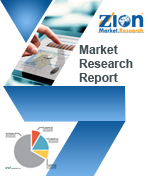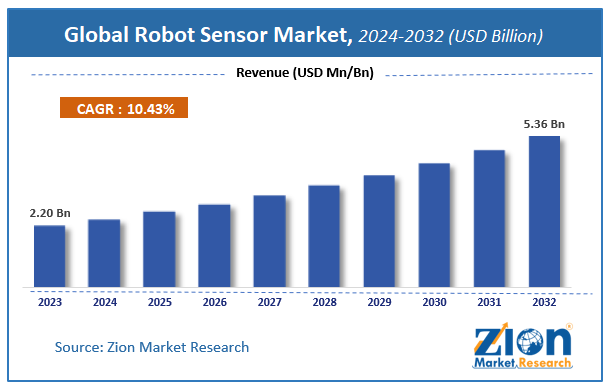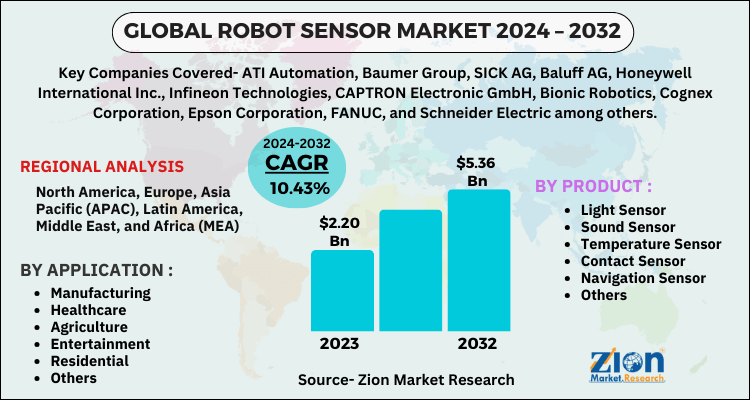Robot Sensor Market Size, Share, Trends, Growth and Forecast 2032

Robot Sensor Market: by Product (Light Sensor, Sound Sensor, Temperature Sensor, Contact Sensor, Navigation Sensor, and Others) by Application (Manufacturing, Healthcare, Agriculture, Entertainment, Residential, and Others): Global Industry Perspective, Comprehensive Analysis and Forecast, 2024-2032
| Market Size in 2023 | Market Forecast in 2032 | CAGR (in %) | Base Year |
|---|---|---|---|
| USD 2.20 Billion | USD 5.36 Billion | 10.43% | 2023 |
The global Robot Sensor Market size was worth around USD 2.20 Billion in 2023 and is predicted to grow to around USD 5.36 Billion by 2032 with a compound annual growth rate (CAGR) of roughly 10.43% between 2024 and 2032.
The market for robotic sensors includes a variety of sensors that are used in robotic systems to improve their efficiency, accuracy, and self-sufficiency. These sensors are essential parts that allow robots to see their surroundings, decide wisely, and carry out jobs precisely. The market is propelled by developments in robotics technology, increased automation trends, and rising use across a range of sectors.
The Robotic Sensors Market report represents gathered information about a market within an industry or various industries. The Robotic Sensors Market report includes analysis in terms of both quantitative and qualitative data with a forecast period of the report extending from 2023 to 2032. The report is prepared to take into consideration various factors such as Product pricing, Product or services penetration at both country and regional levels, Country GDP, market dynamics of parent market & child markets, End application industries, major players, consumer buying behavior, economic, political, social scenarios of countries, many others. The report is divided into various segments to offer a detailed analysis of the market from every possible aspect of the market.
Rising demand in the healthcare sector is driving the market. Robots are manly used in medical transportation, surgical assistance, rehabilitation, and many more. Various organizations that provide robots to this industry are investing heavily in robotics. In 2019, organizations such as Intuitive Surgical Inc. and Corindus Vascular Robotics Inc. invested around USD 2,000 Million and USD 15 Million respectively that are driving the demand for robot sensors. However, high initial investments and maintaining regulatory compliance in the manufacturing of these sensors are anticipated to be major drawbacks for the market development during the forecast timespan. Growing adoption of “Internet of Things” (IoT) is anticipated to open new avenues for the market over the coming years.
Robot sensor market is bifurcated on the basis of product, application, and region. Based on product, the market is further segmented into light sensor, sound sensor, temperature sensor, contact sensor, navigation sensor, and others. The navigation sensor segment is projected to grow at a considerable rate considering the rising investments in technology. On the basis of application, the robot sensor market is divided into manufacturing, healthcare, agriculture, entertainment, residential, and others. The manufacturing segment is anticipated to witness significant demand for the robot sensors over the coming years. This growth is due to the adoption of robots in various assembly lines over the product manufacturing process.
Robotic Sensors Market Trends
The market for robotic sensors is expanding significantly due to developments in automation and artificial intelligence. Advanced sensors are becoming more and more popular in industrial applications as the need for accuracy and economy rises. Furthermore, robotic systems' performance and capacities are being improved through the integration of machine learning and the Internet of Things (IoT), which is driving market growth.
The Rise of Collaborative Robots and the Need for Safer Sensors
The growing use of human-assisted collaborative robots, or cobots, requires advances in sensor technology. Safety is the first priority, and sensors will be essential for force measurement, collision warning, and environmental monitoring to guarantee smooth human-robot interaction. The creation of smarter sensors with quicker reaction times and better data collection capabilities will be fueled by this trend.
The Industrial Internet of Things (IIoT) and Sensor Integration
Data-driven production is entering a new phase thanks to the Industrial Internet of Things' (IIoT) integration with robotic sensors. Real-time data on robot performance, process parameters, and environmental factors will be gathered by sensors. By feeding this data into IIoT systems for machine learning and analytics, it will be possible to increase production efficiency, do predictive maintenance, and operate robots more efficiently
The Convergence of AI and Robotics: Sensor-Fueled Decision Making
In robotics, artificial intelligence (AI) is changing the game. In order to train and strengthen AI algorithms that govern robot behavior, sensor data will be essential. Robots will be able to see their surroundings visually thanks to sensors such as vision sensors, which will enable them to adapt to changing conditions and make decisions on their own. The need for intelligent sensors with cutting-edge processing power and edge computing capabilities will be driven by the convergence of AI and robots.
Robotic Sensors Market Scope Of the Report
This report offers past, present as well as future analysis and estimates for the Robotic Sensors Market. The market estimates that are provided in the report are calculated through an exhaustive research methodology. The research methodology that is adopted involves multiple channels of research, such as – primary research, secondary research, and subject-related expert advice. The market estimates are calculated based on the influence of the current market dynamics along with various economic, social, and political factors on the Robotic Sensors Market. Also, various regulations, government spending, and research and development growth define the market data. Both positive, as well as negative changes to the market, are taken into consideration for the market estimates.
Global Robot Sensor Market: Segmentation
The study provides a decisive view of the Robot Sensor Market by segmenting the market based on By application, By Product and By Region.
By Product Segment, the Robot Sensor Market is segmented into Light Sensor, Sound Sensor, Temperature Sensor, Contact Sensor, Navigation Sensor and others.
The Application Segment includes Manufacturing, Healthcare, Agriculture, Entertainment, Residential, Others.
Robot Sensor Market: Report Scope
| Report Attributes | Report Details |
|---|---|
| Report Name | Robot Sensor Market |
| Market Size in 2023 | USD 2.20 Billion |
| Market Forecast in 2032 | USD 5.36 Billion |
| Growth Rate | CAGR of 10.43% |
| Number of Pages | 196 |
| Key Companies Covered | ATI Automation, Baumer Group, SICK AG, Baluff AG, Honeywell International Inc., Infineon Technologies, CAPTRON Electronic GmbH, Bionic Robotics, Cognex Corporation, Epson Corporation, FANUC, and Schneider Electric among others |
| Segments Covered | By Product, By Application and By Region |
| Regions Covered | North America, Europe, Asia Pacific (APAC), Latin America, Middle East, and Africa (MEA) |
| Base Year | 2023 |
| Historical Year | 2018 to 2022 |
| Forecast Year | 2024 - 2032 |
| Customization Scope | Avail customized purchase options to meet your exact research needs. Request For Customization |
Asia Pacific region is anticipated to capture a substantial chunk of the global robot sensor market over the forecast period. China, South Korea, and Japan are projected to generate huge demand for the product in this region. Rising investments in robotics is fueling the demand for robot sensors. Latin America is anticipated to witness notable rise in the robot sensor market over the estimated timespan. This growth is due to the rising demand for automation in the agriculture sector. Brazil and Argentina are expected to be the most lucrative markets in this region.
Noticeable players in robot sensor market include:
- ATI Automation
- Baumer Group
- SICK AG
- Baluff AG
- Honeywell International Inc.
- Infineon Technologies,
- CAPTRON Electronic GmbH
- Bionic Robotics
- Cognex Corporation
- Epson Corporation
- FANUC
- Schneider Electric among others.
Major players are focusing on acquisition to expand their business and gain a competitive advantage in the market.
The report segment of global robot sensor market as follows:
Global Robot Sensor Market: Product Segment Analysis
- Light Sensor
- Sound Sensor
- Temperature Sensor
- Contact Sensor
- Navigation Sensor
- Others
Global Robot Sensor Market: Application Segment Analysis
- Manufacturing
- Healthcare
- Agriculture
- Entertainment
- Residential
- Others
Global Robot Sensor Market: Regional Segment Analysis
- North America
- U.S.
- Europe
- UK
- France
- Germany
- Asia Pacific
- China
- Japan
- India
- Latin America
- Brazil
- Middle East and Africa
Table Of Content
Methodology
FrequentlyAsked Questions
The market for robotic sensors includes a variety of sensors that are used in robotic systems to improve their efficiency, accuracy, and self-sufficiency. These sensors are essential parts that allow robots to see their surroundings, decide wisely, and carry out jobs precisely. The market is propelled by developments in robotics technology, increased automation trends, and rising use across a range of sectors.
The Robot Sensor Market was valued at USD 2.20 Billion in 2023.
The Robot Sensor Market is expected to reach USD 5.36 Billion by 2032, growing at a CAGR of 10.43% between 2024 to 2032.
This report offers past, present as well as future analysis and estimates for the Robotic Sensors Market. The market estimates that are provided in the report are calculated through an exhaustive research methodology. The research methodology that is adopted involves multiple channels of research, such as – primary research, secondary research, and subject-related expert advice. The market estimates are calculated based on the influence of the current market dynamics along with various economic, social, and political factors on the Robotic Sensors Market.
Prominent Global Robot Sensor Market players such as ATI Automation, Baumer Group, SICK AG, Baluff AG, Honeywell International Inc., Infineon Technologies, CAPTRON Electronic GmbH, Bionic Robotics, Cognex Corporation, Epson Corporation, FANUC, and Schneider Electric among others.
The Regional segment includes the current and forecast demand for North America, Europe, Asia Pacific, Latin America, and the Middle East and Africa.
List of Contents
Robotic Sensors Market TrendsThe Rise of Collaborative Robots and the Need for Safer SensorsThe Industrial Internet of Things (IIoT) and Sensor IntegrationThe Convergence of AI and Robotics: Sensor-Fueled Decision MakingRobotic Sensors Market Scope Of the ReportSegmentationReport ScopeThe report segment of global robot sensor market as follows:Product Segment AnalysisApplication Segment AnalysisRegional Segment AnalysisHappyClients
Zion Market Research
Tel: +1 (302) 444-0166
USA/Canada Toll Free No.+1 (855) 465-4651
3rd Floor,
Mrunal Paradise, Opp Maharaja Hotel,
Pimple Gurav, Pune 411061,
Maharashtra, India
Phone No +91 7768 006 007, +91 7768 006 008
US OFFICE NO +1 (302) 444-0166
US/CAN TOLL FREE +1 (855) 465-4651
Email: sales@zionmarketresearch.com
We have secured system to process your transaction.
Our support available to help you 24 hours a day, five days a week.
Monday - Friday: 9AM - 6PM
Saturday - Sunday: Closed






